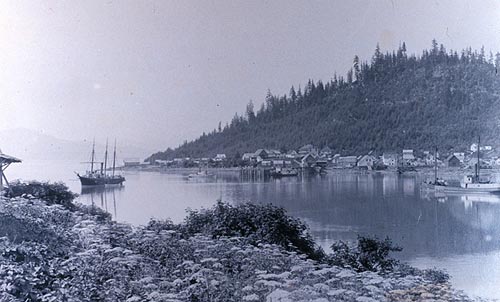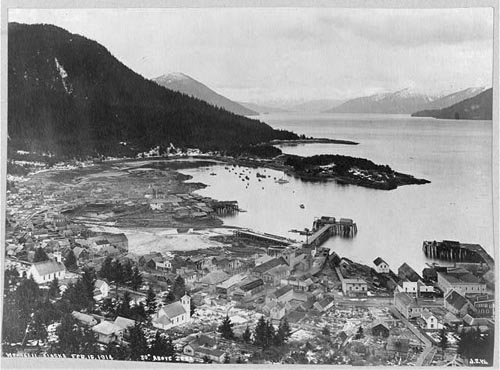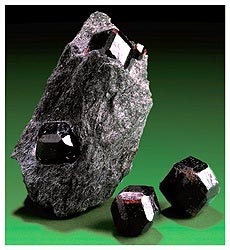 They may gleam in your back yard By June Allen January 11, 2003
By 1912, when fashions began to change, when bloomers and calisthenics for women and girls were being grudgingly accepted, womenfolk were only eight years away from obtaining the right to vote! And they were just opening the era when they would take for themselves the personal rights to throw away their unhealthy corsets for comfortable handkerchief brassieres, to shorten their skirts and to bob their hair. But those were near-future freedoms even as some women nationwide were struggling for equality and parity even in the business world. For example, shortly after the turn of the 20th century, in the Minneapolis-St. Paul area, eleven women founded an all-woman corporation - which may have been a ground-breaker in the nation and was certainly an attention-getter in Alaska, where the ladies' business interests were centered! Their business was named the Alaska Garnet Mining & Manufacturing Corporation, with their mining interest in Wrangell, Alaska, and their manufacturing operation in Minneapolis. The Alaska Garnet Company made the jeweled heads of hatpins, watch fobs, umbrella rib-caps, costume jewelry from beads to brooches, hair clips and decorations for cosmetic boxes, hair collectors, and dresser sets. The corporation's prospectus noted that, "A ruby is scarcely more beautiful than this wonderfully rich, brilliant, fiery gem from the north. It is harder and takes a finer and more lasting polish than the Bohemian garnet. Its hardness is 7.5, only 2.5 points softer than the Kimberly diamond." Even without the publicity hype, the garnet was a fashionable and treasured semi-precious stone, not only in the 20th century but in previous centuries. The word garnet comes from a Latin root meaning "grain," because it reminded the ancients of the fruit of the pomegranate. In German it is called the "karfunkel," which means "sparks of fire." Garnets became incredibly popular during the Victorian period when jewelry enjoyed its heyday. Garnets were often used as the center of a rose design, with other gems surrounding it.  Photo Date: 1890 Ca. Photographer: Archival Photograph by Mr. Steve Nicklas, NGS/RSD Courtesy National Oceanic & Atmospheric Adminstration (NOAA), NOAA Central Library The Secretary and manager of the Minnesota-based all-women's garnet corporation was Anna E. Durkee, apparently a single career woman. Of the other ten, two were married, three were widows, one was single nurse, and four, listed by their given names, may also have been single. So little is known of these women that there is a website hoping to find information about them! The Wrangell Sentinel
announced on August 8, 1907, under a headline of "Corporation
Of Women," and a subhead of "Perhaps the Only Mining
Organization in the World Composed Women" : The purpose
of the Company is to mine the garnets of the ledge near the mouth
of the Stikine River and cut and polish them at the manufacturing
plant. [apparently a quote] "The fact that this is the first
corporation in the world composed entirely of women has been
published in nearly every city in the U.S. We expect every woman
in the U.S. to be interested (and what woman is uninterested
in gems and jewelry) in our project, and in seeing us succeed
It is our plan to create a demand for the exquisite Alaska garnet
and to be able to command a better price than for other garnets.
The motto of the company is Progress: Success." The successful
mine was, for a moment in history, Wrangell's claim to fame. The town began as a Russian fort near today's Wrangell in 1833, named Redoubt Fort Dionysius, a simple Russian fortification surrounded by a solid fence of pointed logs. Above it flew the double eagle flag of Russia, the two-headed bird with a crown on one head and a cross on the other. The fort's location was at the mouth of the navigable Stikine River, a door to the Pacific coveted by Canada's inland Hudson's Bay Company. However, it was in Russian territory as per the 1825 treaty between Britain and Russia, so the Russians chose to defend its property and trading rights. Two armed brigs sent down from Sitka stood guard, ready to fire upon the intruder. And fire they did at the approach of the British vessel, which beat a hasty retreat upriver. By 1840, however, the Russians discovered that fighting the warlike Stikine Indians, guarding against British intrusion and manning the isolated redoubt was more trouble than it was worth and so the Russians agreed to lease the site to the British in return for foodstuffs and supplies for their always under-provisioned capital of Sitka. So then the Union Jack flag flew over Wrangell for the next 27 years, until the U.S. Purchase of Alaska from Russia in 1867, when America's Stars and Stripes were hoisted above the town. Wrangell's garnet ledge was well known to prospectors who stampeded up the Stikine during its gold rush of the 1860s. The garnet rich site was probably known as well to the disappointed Wrangell gold prospectors of 1897, a number of whom moved down to Ketchikan and became civic leaders in the new city on Tongass Narrows.  February 15, 1914 Forms part of: Frank and Frances Carpenter collection (Library of Congress) Gift; Mrs. W. Chapin Huntington; 1951 Courtesy Library of Congress Prints and Photographs Division Washington, D.C. It took the women's Alaska Garnet corporation to recognize the value of the garnet and move to develop the garnet mine. And succeed they did, continuing operations until 1922. By that time, there had been a revolution in fashion! The dated jewelry and fashion accessories of the early century were passé, and the flapper fashions and little tight-fitting hats did not require or allow such ostentation. In 1922 the Minnesota women's corporation let a short-term lease to another company, which operated the mine through the 1920s and until 1936. Eventually, the property was transferred to the ownership of Fred Hanford of Wrangell. In 1962, the 83-year-old Hanford deeded the garnet ledge to the Southeast Council of the Boy Scouts of America "for so long as the said grantee shall use the land for Scouting purposes and shall permit the Children of Wrangell to take garnets there in reasonable quantities." It is the children of the town who own the site and have free use. Adults must buy permits and donate 10 percent of their take to the Wrangell Boy Scouts. Over the years children have offered their garnets for sale to state ferry passengers and to tourists. Charter boats offer the garnet ledge as a tour option. Nearby Forest Service cabins may be reserved. Interestingly, Wrangell Island isn't the only place in Alaska with garnets, although no one has as yet mentioned finding a ledge such as Wrangell's elsewhere in the state. There are garnet industries in New York and Montana, mining the stones for garnet paper and other related products. The mining industry authors of a 1964 mining document under the aegis of Alaska's Gov. Bill Egan suggests the possibility of a garnet mining industry in southern Southeastern. Garnets, like gold nuggets, are where you find them! Garnets have been found in creeks and rivulets that tumble down the hillsides along the North Tongass Highway. They are easy to spot, dark red, faceted and shinier when wet than when dry. And those of you with garnet birthstone jewelry: look at it closely and appreciate it. They may be semi-precious stones but they are precious to their owners, and, they have their own place in history!
All rights reserved. Not to be reprinted in any form without the written permission of June Allen.
|
||
